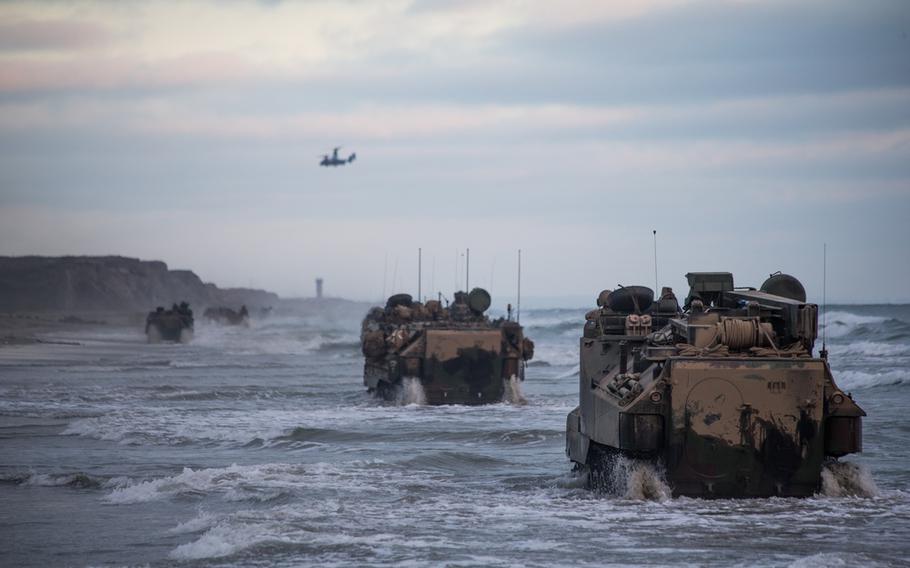U.S. Marine Corps 1st Lt. Thomas MacAleese, a platoon commander with Bravo Company, Battalion Landing Team 1/4, 15th Marine Expeditionary Unit, is photographed during sustainment training at Marine Corps Base Camp Pendleton, Calif., July 10, 2020. (Brendan Mullin/U.S. Marine Corps)
(Tribune News Service) — The third of six planned separation boards convened at Marine Corps Base Camp Pendleton Tuesday as the service weighs what to do with the officers and senior enlisted leaders blamed for the fatal sinking of an assault amphibious vehicle off the San Diego coast two summers ago.
First Lieutenant Thomas MacAleese is accused of substandard performance and dereliction of duty as the platoon commander of the AAV platoon sent to the 15th Marine Expeditionary Unit in the spring of 2020 ahead of a planned deployment that fall.
The sinking under his watch led to the deaths of eight Marines and one sailor.
Three boards of inquiry are already in the books. One, into the former commander of the 3rd Assault Amphibian Battalion, Lt. Col Keith Brenize, was held at Marine Corps Base Quantico, Va., in December. Boards of inquiry into the former BLT commander, Lt. Col. Michael Regner, and the former Bravo Company commander, Capt. George Hepler, were held on Camp Pendleton earlier this month.
After MacAleese’s board, two enlisted Marines will face administrative separation boards — the platoon sergeant and the vehicle commander of the lost amtrack, as the vehicles are referred to in the service.
In the military system, officers are sent to boards of inquiry while enlisted personnel face separation boards when their performance or negligence does not merit criminal prosecution. All the Marines face separation from the Corps.
The Camp Pendleton-based I Marine Expeditionary Force, which is responsible for the boards, will not release their results until all are complete and their recommendations are reviewed by the MEF commander and the Navy secretary — a process that could take months.
“(The) decisions from the board members of the BOIs and ADSEP boards, as well as decision by the convening authority, the I Marine Expeditionary Force (MEF) Commanding General (CG), as it relates to BOIs, are not final actions and are considered pre-decisional, not for public release,” said 2nd Lt. Katarina Vogel, a IMEF spokesperson, in an email.

U.S. Marines with Bravo Company, Battalion Landing Team 1/4, 15th Marine Expeditionary Unit, drive AAV-P7/A1 assault amphibious vehicles through the surf during sustainment training at Marine Corps Base Camp Pendleton, Calif., July 14, 2020. (Brendan Mullin/U.S. Marine Corps)
On July 30, 2020, Marines and sailors from 1/4 left the amphibious transport dock ship Somerset in 13 AAVs and rode to San Clemente Island, Calif. for training. While the amtrack crews had operated their vehicles in the ocean before, it was the first time the infantry Marines conducted waterborne operations in them.
While on the island, one vehicle broke down and could not return to the ship. Amtrack No. 5 — the one that later sank — had an oil leak. Marines added six gallons of oil to it before splashing back into the Pacific with eight other amtracks, one of which almost immediately began taking on water and had to be towed back to the island by another.
According to the Marine Corps’ investigation, AAV No. 5 began taking on water but the vehicle commander delayed ordering an evacuation. By the time it was apparent the vehicle was going to sink, it was too late. Another AAV pulled up alongside the vehicle to rescue the troops but collided with it, sending it sideways into a crashing wave that inundated the amtrack through its open top hatch, and led to the drowning of the nine servicemembers.
Investigations into the accident found that in addition to the delayed evacuation, the infantry Marines on board had not been fully trained to evacuate the vehicles, nor were they all swim-qualified. The tracks themselves were in such poor mechanical condition that the investigating officer called them “garbage” when he testified during Regner’s board.
The investigation found fault in Marines all the way up the platoon’s chain of command to the commanding general of the 1st Marine Division at the time, Maj. Gen. Robert Castellvi. Castellvi was forced out of his subsequent job as the Corps’ inspector general in the wake of the investigation.
At the boards held on Camp Pendleton this month so far, Marine Corps officers have pointed fingers above and below them in the chain of command, saying that senior leaders knew about the problems with the vehicles and training and that subordinates didn’t always provide an accurate accounting of training and material readiness.
Aaron Myer, MacAleese’s civilian lawyer, told the three lieutenant colonels that comprise his board the young officer did everything he could to get the vehicles repaired and raised concerns about training repeatedly to his superiors.
“If MacAleese was listened to, these men would not be dead, and that is a fact,” Myer said.
MacAleese’s board is set to resume on the base Thursday.
©2022 The San Diego Union-Tribune.
Visit sandiegouniontribune.com.
Distributed by Tribune Content Agency, LLC.